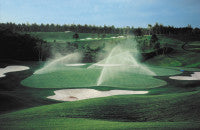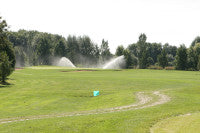Irrigation system design
 It is often said that all that is needed to provide a successful irrigation system is sufficient water, an adequate power supply and enough money!
It is often said that all that is needed to provide a successful irrigation system is sufficient water, an adequate power supply and enough money!
The importance of being able to quantify the size of electrical and water supplies cannot be overstated.
Not only can irrigation systems be expensive, but they can also take a long time to complete.
If you retain irrigation consultants for your design work then they will normally advise on these requirements as a matter of course.
Should you choose to deal with irrigation companies directly then you should be aware that the provision of the appropriate electrical and water supplies is almost always down to the client and is not always included in the contract for the irrigation system. In order to get a realistic overall price for an irrigation system these aspects need to be included and, if necessary, acted upon as early as possible.
To obtain a rough estimate of your requirements it is not necessary for the detailed design to be completed. Being able to answer the following simple questions should allow your system designer to tell you if your existing services are adequate or by how much they require upgrading.
What Requires Watering
Not only do you need to know what areas you want to water, you should also identify any plans you may have for incorporating new areas in the future. Making provision at day one for future needs is always more cost effective than trying to upgrade later. Obviously, the larger the area to be watered, the higher the cost of the overall scheme is likely to be.
How Much Water
Unless you specify differently, it should normally be assumed that the required precipitation for golf greens would be 4.6mm/day, tees - 3.6mm/day, approaches - 4.0mm/day and fairways - 3.0mm/day. These figures are more than adequate for the vast majority of locations in the UK. Other sports turf requirements would normally be in the range of 25 to 32mm/week for design purposes.
Once the above factors have been established, the amount of water the system needs to be able to operate successfully can be roughly estimated. Experience is essential in providing this estimate, as allowances need to be made for any system inefficiencies due to overthrowing of sprinklers etcetera. The larger and more regularly shaped the areas to be watered, the more efficient the system in terms of water usage.
Similarly, small golf tees and very irregularly shaped greens result in higher water usage than their area would initially indicate. This early estimate is extremely important to ensure that enough water is available. If this water requirement cannot be met from your present source then consideration must be given to reinforcing the water supply.
When To Water
For the most part it is best to water at night when the winds are lighter, temperatures lower and the irrigated areas are not being played on. Defining the time in which all irrigation must be completed (the irrigation window) is a critical part of the design, particularly for golf courses. The shorter the irrigation window, the faster water needs to be applied with obvious impact on pump and pipe sizing. An extreme example of this is the watering requirements for synthetic hockey pitches where 2mm of water needs to be applied to the pitch in 10 minutes which, inevitably, results in large pumps, pipes and the use of rain guns or similar.
The irrigation window and the amount of water required allows a rough estimate of the rate at which water needs to be applied. This, in turn, will give a ballpark figure for the pumping requirements and the approximate size of the required electricity supply.
As with water usage, experience is needed to make this estimate as the topography of the site, location of the pump house, envisaged arrangement of pipework and allowances for future expansion all influence pump selection. It is fairly obvious that a pump house sited on top of a hill will require less pressure from the pump(s) than one sited at the bottom. Similarly, long pipe runs may require some added pressure to compensate for friction losses.
In Conclusion
Whilst the precise figures for water and power requirements can only be ascertained once the detailed design has been finalised, it is important that some early indication of their likely value is made. Increasing the size of your abstraction licence, upgrading your town water main or reinforcing your electrical supply can prove both expensive and time consuming. Where the situation is marginal then, to an extent, it is possible to design around the problem but compromises will need to be made which will, invariably, limit the performance of your system.
About the author: Simon Leathley is Operations Director for Enviropro H2O Ltd - www.enviroproh2o.com
